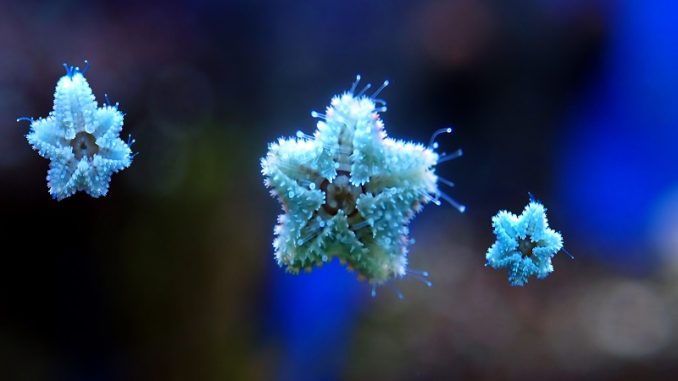
The Asterina Starfish is not a standard aquarium fish. Many people will define this aquatic creature as a parasite or pest, while others see it as a harmless and attractive addition to any home tank.
These small stars suddenly appear on pieces of rock or coral in your tank, and probably arrived on the scene with whatever decorations you most recently purchased.
While Asterina Starfish are attractive in the eyes of many aquarium owners, there is a danger of them preying on coral, and they will be hard to find as they usually only emerge from hiding at night.
This article contains all the information you need about Asterina Starfish and will help you decide whether to leave them in your tank or make an effort to get rid of them completely.
TABLE OF CONTENTS
Asterina Starfish Facts & Overview
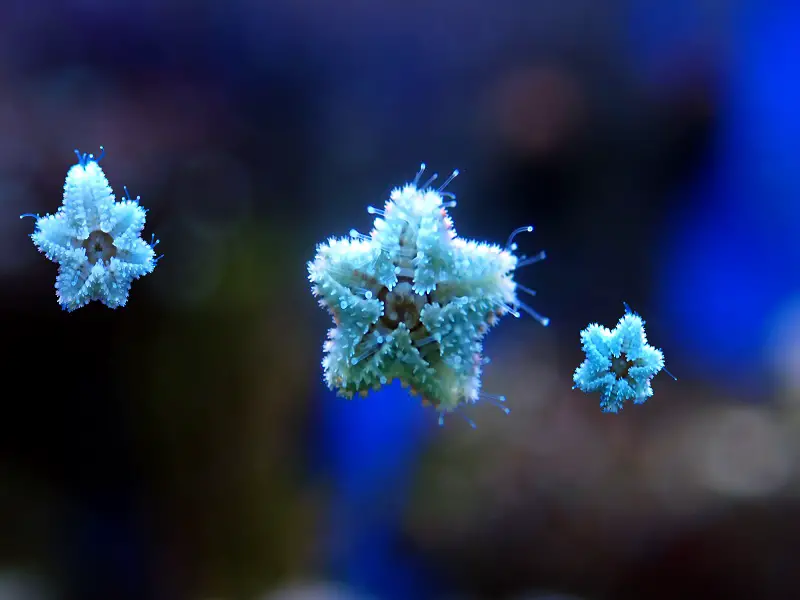
| Category | Rating |
| Care Level: | Easy |
| Temperament: | Peaceful |
| Color: | Red, yellow, grey, or white |
| Lifespan: | Unknown |
| Size: | 0.2 – 0.8 inches |
| Diet: | They consume microorganisms or become non-selective omnivorous if natural food is lacking |
| Family: | Echinoderm - Asteroidea |
| Minimum Tank Size: | The larger the tank, the more they reproduce |
| Tank Setup: | Saltwater with an oolitic aragonite substrate |
| Compatibility: | All marine fish and invertebrates |
Asterina Starfish are marine invertebrates. There are 15 known species of Asterina Starfish in the world. They are also known as “Bat Stars” because of their webbed arms.
While many Asterina Starfish dwell in shallow water (3 – 5 meters deep), some members of the species can be found at up to 150 meters below the surface.
This aquatic creature prefers a coarse substrate, consisting of rocks, stones, and/or sand. They make their way into home aquariums when people collect live rocks from reefs and sell them to pet stores. The Asterina Starfish is often referred to as a “hitchhiker”, as it often ends up far from home after “catching a ride” on a rock or piece of coral removed from its natural habitat.
Asterina Starfish adapt well to almost all tank conditions, including temperatures as low as 45F (8C). They don’t need any special food, so if you decide to keep some as pets, know that it will require almost no care – except for making sure they don’t multiply to the point where they take over your entire aquarium!
Asterina Starfish are not expensive. They cost about $2 dollars apiece if you buy a group of 10. After introducing them to your tank, they will probably immediately begin to reproduce, providing an abundance of fresh food for any harlequin shrimp you own.
Typical Behavior
Asterina Starfish are most active at night, or when the lights are off in the aquarium and room. Unlike your fish that swim around the tank showing off their beautiful shapes and colors, Asterina Starfish mainly stay close to their feeding areas.
It can be interesting to watch an Asterina Starfish eat algae on the glass walls of your tank. They latch on to the glass with their suction-cupped legs and then extend their stomachs out of a central cavity on the bottom of their bodies. Asterina Starfish have translucent stomachs on the underside of their hard shells. This creature’s soft stomach often appears salmon-colored when extended.
Appearance
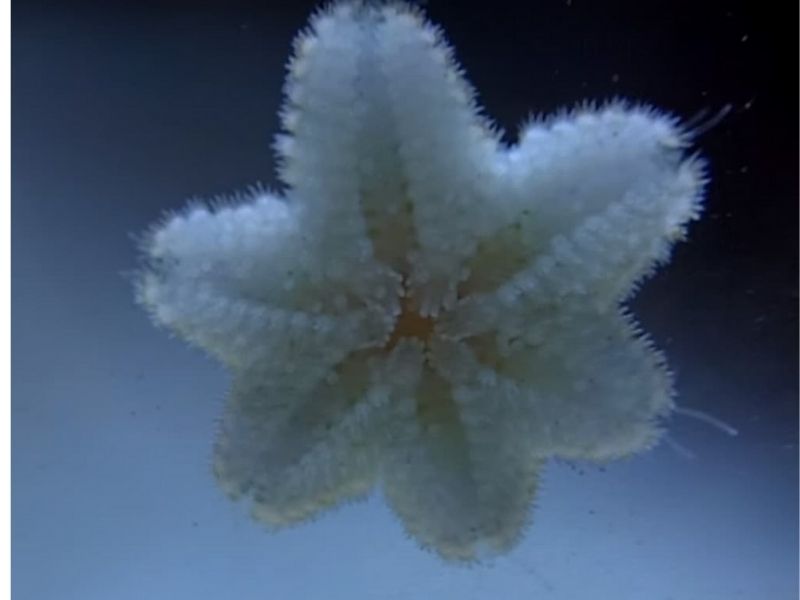
The basic body shape of Asterina Starfish is a pentagon, with up to five short, rounded tipped arms extending outwards from the body. Most Asterina Starfish are asymmetrical, due to their method of reproduction, which involves shedding one or more legs. While some Asterina Starfish have all five legs, others look like little blobs of tissue with no legs at all, or legs of differing lengths.
Some have full sets of legs on one side of the body and no legs at all on the other. It can be said that no one Asterina Starfish is like any other, since they are repeatedly involved in the act of splitting and regrowth.
Short spines line the underside of the Asterina Starfish’s arms, in groups of 2 – 6. The spines usually appear in pairs and run all the way to the tips of the arms. There are also 3-4 spines on each of the mouth angle plates. There are rarely any spines on the inside of the mouth.
The Asterina Starfish can be red, yellow, grey, or white, with a flat body. They never grow larger than 2 centimeters, which is less than an inch, and, therefore, are sometimes hard to find in an aquarium filled with plants.
Habitat and Tank Conditions
Asterina Starfish are saltwater dwellers, and will not survive in a freshwater tank. So only readers who own saltwater tanks need to be concerned about the possible arrival of this miniature pest.
If you do decide to purchase Asterina Starfish or keep the ones you suddenly discover in the tank, it is important to make sure they have enough food to eat, and a substrate that most closely resembles their native environment.
The optimal substrate for Asterina Starfish – and for marine and reef tanks in general – is oolitic aragonite. This unique calcium carbonate is found in the Bahamas. It is renewable and is, therefore, an environmentally responsible choice. Oolitic aragonite naturally helps maintain a pH balance of 8.2, making it unnecessary to purchase and add chemicals to the tank.
If you decide to purchase oolitic aragonite for the Asterina Starfish in your aquarium, make sure you are getting the real thing. Oolitic aragonite consists of spherical, smooth grains. “Oolitic” means “egg-shaped”. If the grains in the product you inspect are angular and rough, they are probably regular sand or crushed shells.
Sometimes you will find a substrate that contains both types of grains, meaning it’s a mix. That is ok to use because it still contains enough oolitic aragonite to benefit your tank.
Tank Conditions
Asterina Starfish thrive in saltwater, at all depths, and in a wide range of temperatures. Because they are so adaptable with regard to tank conditions and diet, they have a tendency to reproduce at a faster rate than most other aquatic creatures. If you want to raise them with other fish, then adjust the tank conditions to the needs of those other fish. If you want to get rid of the Asterina Starfish in your tank, changing the tank temperature or pH levels won’t be effective at all.
Tank Mates
Asterina Starfish have no way of attacking the fast-moving fish in your tank. But they can certainly make a move on zoanthids. In some cases, the zoas will be left in peace by the Asterinas, and in other instances, the Asterinas will consume every zoanthid in sight.
Bumblebee shrimp, like Harlequin shrimp, will eat the Asterina Starfish. This is a good choice of shrimp to add to the tank if you want to get rid of all the Asterinas because they subsist on other foods as well. Harlequins eat only Asterina Shrimp, and you will have to make sure you have an ongoing supply if you want to keep them in your tank long term.
Can You Keep Asterina Starfish Together?
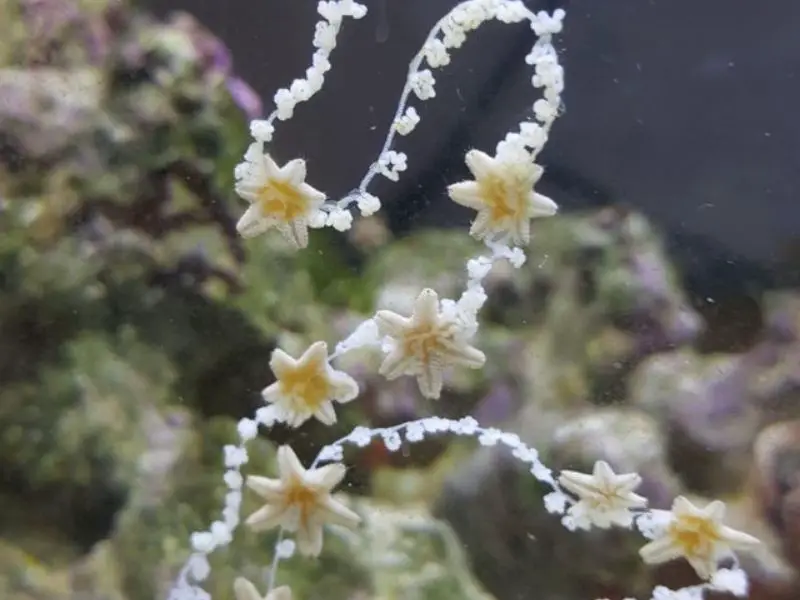
Asterina Starfish tend to live in groups, and even if you decide to purchase one or two of these creatures, if left to their own devices they will reproduce until there are dozens in your tank.
One way to enjoy looking at Asterina Starfish without worrying about damage to your tank is to keep a separate tank just for these little creatures. If you discover a mass infestation in your aquarium, remove all other fish and invertebrates to a new tank. Then introduce one or two Harlequin shrimp into the tank with the Asterina Starfish. The shrimp will be happy to have such an abundance of food, and won’t be in danger of being eaten themselves by predatory fish.
Diet
In captivity, if Asterina Starfish experience nutritional deficiencies, their dietary needs change to help them adapt to the new environment. In that case, they begin to eat anything they can find. Since it is very difficult for laymen to identify a particular species of Asterina Starfish, it is equally hard to provide it with the food it naturally requires. So keeping your Asterina Starfish fed and satisfied is a hit-or-miss situation.
Make sure you have plenty of medium to large oolite aragonite in the tank’s substrate. This naturally formed rock will provide microorganisms for the Asterina Starfish to feed on, preventing them from devouring your coral. Raising coralline in your tank, which is a type of red algae, will also provide food for Asterinas.
Regardless of whether you have natural or synthetic substrate, there are a few species of Asterina Starfish that are known as “non-selective omnivorous feeders”. Even when provided with other forms of food, they eat anything they find, including corals, algae, and polyps. These species include:
- Asterias Gibbosa: Eats algae, coralline algae, cyanobacteria, detritus, tiny worms, and diatoms, and in some cases, they have been observed eating Palm Tree Polyps (Clavularia sp.) and Corky Sea Finger (Briareum asbestinum). Asterias gibbosa are prone to get stressed and frequently shed their legs, which then grow into new starfish. If you end up with this species in your tank, you will have to buy shrimp to keep the population to a controllable number.
- Asterina Sarasini: Very difficult to find in the tank, as they rarely emerge from their hiding places during daylight. They eat cyanobacteria, detritus, and corral. They tend to live in large groups, and together can consume dead or damaged corals in a matter of hours.
- Asterina Stellifera: In captivity, this species eats as similar proportions of various foods as it would in the wild. When there is a high density of adults in a tank, they have been known to eat each other.
- Asterina Coronata: A skilled “hitchhiker” and is the most commonly discovered species in reef tanks. Native to China, Indonesia, and Vietnam, they are difficult to see when they are small. They feed on diatoms, cyanobacteria, and detritus, and can quickly procreate and take over your tank.
As a family, Asterina Starfish feed on coral reefs. Since many Asterina Starfish are opportunistic feeders, they can severely damage or diminish the size of any zoanthid corals you have in the tank. If you find that the amount of Asterina Starfish in your tank is getting out of hand, you can decrease their numbers by introducing Harlequin shrimp – which will eat the starfish – and at the same time limit the amount of food in the water by installing a filter that removes floating particles.
Finally, when the Asterina Starfish emerge at night to feed on your coral, look for them and physically remove as many as you can by hand. This little creature may be cute, but at the end of the day, it is in fact an aquarium pest.
Care
Asterina Starfish don’t need any special care if you want them in your aquarium. The only thing to be worried about is that if their nutritional needs aren’t met, they will begin to consume your coral.
Actually, only 5% of Asterina Starfish species are documented as being coral eaters. It is rare for those that don’t subsist on coral to suddenly develop a taste for that particular dish. There are experienced aquarists who have kept Asterina Starfish in their tanks for up to 20 years without any problems. On the other hand, if you have the bad luck to fall in that 5% group, getting rid of the little pests in your tank will be as difficult as trying to rid your home of termites or cockroaches.
The question about Asterina Starfish is not how to care for them, but rather, is how to get rid of them. How can you clean your tank of Asterina Starfish, if you decide that the presence of these aquatic pests are hampering proper care of the other fish and coral you intentionally chose to raise and enjoy?
There are several steps to take if you want to rid your tank of all Asterina Starfish:
- Decrease the amount of manufactured and live fish food you add to your tank.
- Remove any dead Asterina Starfish from the tank as soon as you discover them. If too many die at once they will produce ammonia when they begin to rot. Test the water parameters regularly, to ensure the well-being of the fish you want to keep.
- To remove live Asterina Starfish from any surface in the tank, try sucking them up with a turkey baster. This is better than using tweezers, which can cause the Asterina Starfish to lose one or more legs, which then grow into new starfish!
- Introduce Harlequin shrimp into the tank to eat the Asterina Starfish. A complication can arise if there are not enough shrimp to sustain the shrimp long term, in which case you should give the shrimp away. Otherwise, they can eat other species of starfish you placed in the tank, no matter how large they are.
Breeding
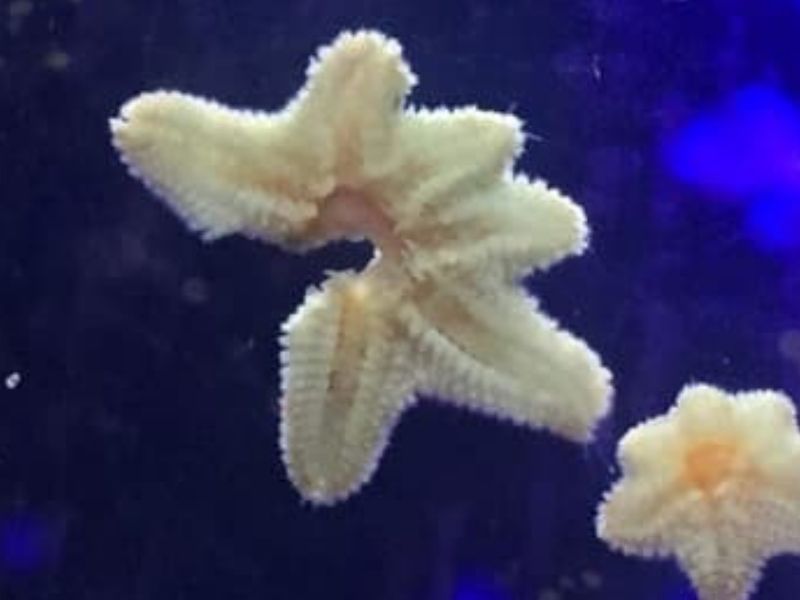
If you notice that any of your Asterina Starfish seem to be missing one or more limbs, or if it appears that some predator tore an Asterina apart, you can rest assured that no harm has been done.
Asterina Starfish don’t breed with each other but instead reproduce asexually by splitting in half across their centers or engaging in autotomy. This means that they drop or “shed” one or more legs – a form of self-amputation – followed by the legs generating new stars.
The separated legs are sustained by stored nutrients until a disc and mouth regrow, and the new Asterina Starfish is able to eat.
Are Asterina Starfish Suitable for Your Aquarium?
Most aquarists will answer that question with a firm “No!” The Asterina Starfish in your tank are like weeds in your garden. At first, you might look at them and think they are kind of pretty, but they can quickly get out of control and attack their neighbors.
Some people have Asterina Starfish in their tanks for years, without suffering any noticeable damage. But the potential for havoc is always there, and it isn’t worth taking a chance if you truly value your coral and polyps.
On the other hand, many people claim that Asterina Starfish are wonderful for keeping their tanks clean. They latch onto the glass walls and consume all the algae growing there.
Before forming an opinion about Asterina Starfish, it is important to consider the following question which has been posed by many aquarists. Are Asterina Starfish responsible for the damage and death of coral because they are eating it? Or do some Asterina Starfish start eating coral in a tank, because the stony formations are already diseased and dying?
Summary
If you are willing to take a small risk that the starfish you raise as pets may one day become annoying pests, you can introduce Asterina Starfish into your tank.
If you never considered raising Asterina Starfish, but discover one day that one or more of these little creatures in your tank, then accept as a fact of nature that this hitchhiker creature has arrived to stay.
Asterina Starfish don’t need any special care if you decide to keep them, and if you choose to get rid of them there are several natural options to choose from.
Are Asterina Starfish your starfish species? Let us know in the comments below…


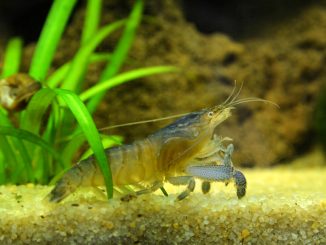
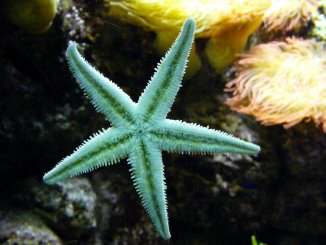

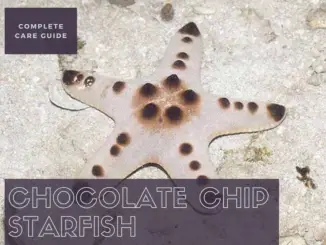
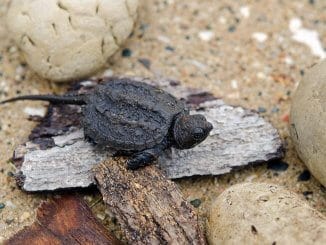
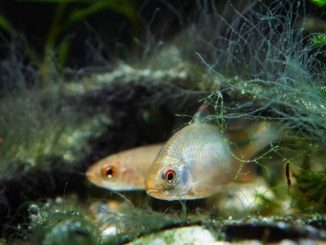
Be the first to comment